|
Wallace Nutting and the Invention
of Early America
by Bob Brooke
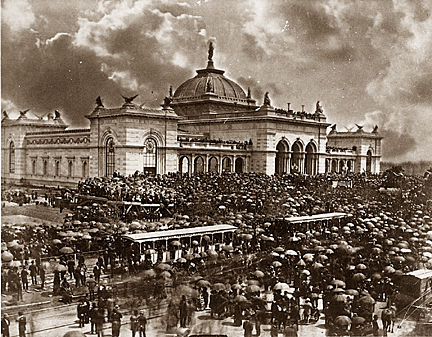 It was 1870 and most Americans were
looking ahead. New inventions appeared every day. Innovations were
everywhere. So why look back. History was in the past. The future meant
progress. Then an event—The Philadelphia Centennial Exposition—changed
everything. It was 1870 and most Americans were
looking ahead. New inventions appeared every day. Innovations were
everywhere. So why look back. History was in the past. The future meant
progress. Then an event—The Philadelphia Centennial Exposition—changed
everything.
During the summer of 1876, thousands flocked to the Exposition to see
all the latest inventions. But they also got to take a look at America’s
past, for the fair celebrated the 100th anniversary of the founding of
the United States. And for the first time, history meant something.
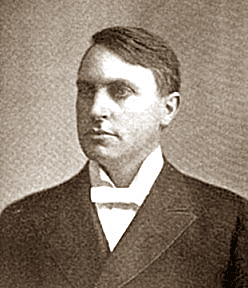 Wallace Nutting was 15 at the time. After graduating high school, he
studied at Phillips Exeter Academy, Harvard University, Hartford
Theological Seminary and Union Theological Seminary. He graduated from
Harvard in 1887 and earned a Doctor of Divinity degree from Whitman
College in 1893. Wallace Nutting was 15 at the time. After graduating high school, he
studied at Phillips Exeter Academy, Harvard University, Hartford
Theological Seminary and Union Theological Seminary. He graduated from
Harvard in 1887 and earned a Doctor of Divinity degree from Whitman
College in 1893.
Nutting became a popular Congregational minister, but poor health forced
him to retire at age 43. He suffered from fatigue, headache, and
irritability as a result of an emotional inbalance, so his wife, Mariet,
suggested bicycling as a means of relaxation and to improve his health.
It was on these bicycle rides in the countryside that Nutting started
taking photographs. One rainy day he experimented with interior
photographs of early American life.
In 1904 he opened the Wallace Nutting Art Prints Studio on East 23rd
Street in New York. A year later, he moved his business to a farm in
Southbury, Connecticut, which he called "Nuttinghame.” In 1912 he once
again moved his photography studio to Framingham, Massachusetts, to a
home he called "Nuttingholme." That year he published a 97-page catalog
of prints that included about 900 images. By 1915, Nutting claimed to be
earning $1,000 per day.
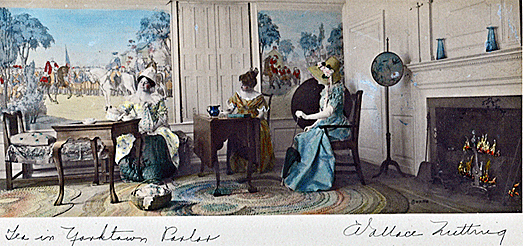
 During these years. he took interior and exterior photographs of
colonial homes while 200 colorists hand colored and signed them with the
Wallace Nutting signature. Although his photographs covered a variety of
subjects and prices to suit many tastes, including pastoral views of
abbeys, cathedrals, bridges, mountains, flowers, and winding roads, one
of his favorite themes was "Colonials." These photos fetured women in
traditional 18th-Century costumes placed in scenes with Colonial
furniture. His prints sold from $1.25 to $20. During these years. he took interior and exterior photographs of
colonial homes while 200 colorists hand colored and signed them with the
Wallace Nutting signature. Although his photographs covered a variety of
subjects and prices to suit many tastes, including pastoral views of
abbeys, cathedrals, bridges, mountains, flowers, and winding roads, one
of his favorite themes was "Colonials." These photos fetured women in
traditional 18th-Century costumes placed in scenes with Colonial
furniture. His prints sold from $1.25 to $20.
Nutting was a marketing genius. He became an antiquarian entrepreneur
who created a consumer empire based upon the past. Nutting produced
hand-tinted photographs, books, high-end reproduction furniture, and a
variety of domestic accessories for the middle class. Nutting sold a
complete vision of the past, much like Martha Stewart offers `good
things in a variety of different media. He was fussy and uncompromising
about quality and shared his generation's interest in the Ruskinian
teachings of the Arts and Crafts Movement.
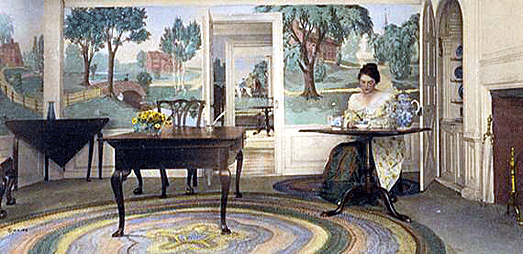
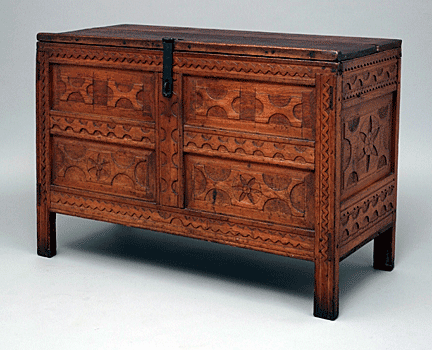 Nutting had a collection of furniture which he used as props in his
"Colonial" photography. This led him to start a business manufacturing
and selling reproduction furniture. His major goal was to preserve the
heritage of America by offering quality antique reproductions at prices
middle-class Americans could afford. Before adding a piece to his line,
he tried to purchase an original piece or else gained permission for his
skilled crafts-men to make exact drawings from an antique someone else
owned. Ever the promoter, Nutting advertised his furniture as antiques
for tomorrow. The variety and quality of furniture listed in his
catalogs, from footstools to bookcases, would challenge any 21st century
manufacturer. Nutting had a collection of furniture which he used as props in his
"Colonial" photography. This led him to start a business manufacturing
and selling reproduction furniture. His major goal was to preserve the
heritage of America by offering quality antique reproductions at prices
middle-class Americans could afford. Before adding a piece to his line,
he tried to purchase an original piece or else gained permission for his
skilled crafts-men to make exact drawings from an antique someone else
owned. Ever the promoter, Nutting advertised his furniture as antiques
for tomorrow. The variety and quality of furniture listed in his
catalogs, from footstools to bookcases, would challenge any 21st century
manufacturer.
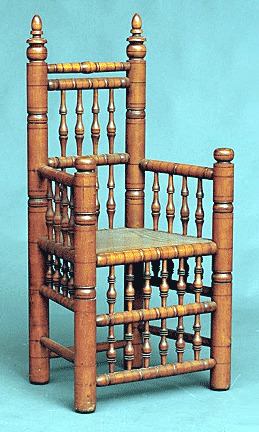 Nutting also felt the Wallace Nutting signature on a furniture item
meant the customer was getting the very best quality, along with an
exacting reproduction. After finding out unscrupulous dealers were
removing his label, aging the item and selling it as old, Nutting
started his block banded signature. Today, these signatures have become
important to collectors. Nutting sold the company in the early 1920s and
the new owners used script signatures. Nutting also felt the Wallace Nutting signature on a furniture item
meant the customer was getting the very best quality, along with an
exacting reproduction. After finding out unscrupulous dealers were
removing his label, aging the item and selling it as old, Nutting
started his block banded signature. Today, these signatures have become
important to collectors. Nutting sold the company in the early 1920s and
the new owners used script signatures.
When Nutting didn't like the work produced using his name, he sold his
collection of original antique furniture to gain funds to buy back the
company. Financier J.P. Morgan bought these Puritan masterpieces and
donated them to the Wadsworth Atheneum. While the furniture business
continued through the 1930s, it was never really profitable.
Wallace Nutting furniture remains popular today because of its high
quality and useability. The labels are identifiable and carry a level of
provenance.
Nutting religiously followed what he called his Ten Construction
Commandments which he published for the workers of his Wallace Nutting
Furniture Company for Christmas 1925:
1. All work is to be of the best quality.
2. If the old method is best, use it.
3. If the work can be done better by hand, do it that way.
4. Use long and large mortises, and large square white oak pins.
5. Make all joined work fit perfectly, using draw bore where it is
better.
6. Match the color where two pieces come together.
7. Follow the sample strictly. Take no liberties.
8. The hand and the mouth do not work effectively at the same time.
9. Keep busy, do your best, and no fault will be found.
10. Let nothing leave your hands until you are proud of the work.
Besides all of his photographs and furniture, Wallace Nutting published
over a dozen books, including his best-known work, The Furniture
Treasury, a three-volume set containing more than 5,000 illustrations of
mostly American early furniture and utensils. Many consider it to be the
bible of early American furniture.
<
More Special Features
Next Article > |
